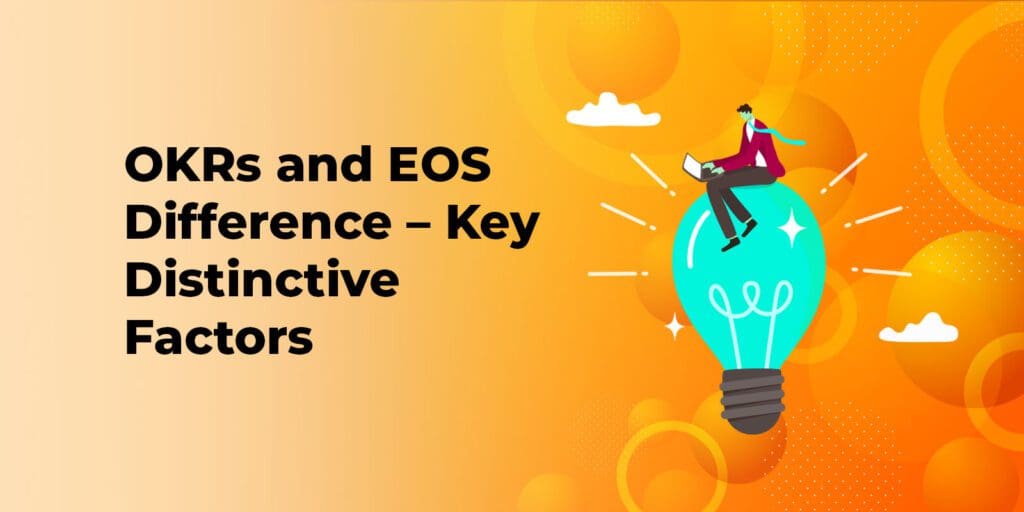Table of Contents
OKRs and EOS Difference – Key Distinctive Factors
Business leaders and entrepreneurs looking to grow their companies must set goals, prioritise them, and implement strategies to achieve them. Goal-setting systems like Objectives and Key Results (OKRs) and Entrepreneurial Operating Systems (EOS) help businesses achieve their objectives. The primary goal of OKRs and EOS is to help businesses grow, but they differ in approach and execution. This article explores the key differences between OKRs and EOS to help business leaders and entrepreneurs choose the most effective goal-setting system for their businesses.
Introduction to OKRs and EOS
Objectives and Key Results (OKRs) is a goal-setting framework that helps businesses achieve their objectives. OKRs were popularised by John Doerr, an investor in Google, Intel, and Amazon. OKRs consist of objectives and key results.
Objectives are the overarching goals a business wants to achieve, while key results are the specific, measurable outcomes that will help businesses achieve their objectives.
The Entrepreneurial Operating System (EOS) is a comprehensive system that helps businesses achieve their vision. EOS comprises six components: vision, people, data, issues, process, and traction. EOS is an all-encompassing system that helps businesses align everyone in the organisation with the company’s long-term goals. EOS ensures that everyone in the organisation is working towards achieving the same objectives.
Objectives and Key Results (OKR) vs Entrepreneurial Operating System (EOS) – Key Differences
EOS differs from OKRs in that it is more comprehensive. EOS covers all aspects of a business, including vision, people, data, issues, processes, and traction. OKRs, on the other hand, focus on setting and achieving goals. EOS ensures that everyone in the organisation is working towards achieving the same objectives. At the same time, OKRs help businesses prioritise their goals and ensure that they are making progress towards achieving their long-term goals. With that in mind, let’s walk through the key differences one by one.


Time Frame – How OKRs and EOS Differ in Setting Goals
One of the most significant distinctions between OKRs and EOS is the time frame for setting goals. OKRs are set quarterly, while EOS is designed to help businesses achieve their long-term vision.
EOS is focused on creating a 10-year target for the company and then breaking that target down into smaller, achievable goals. On the other hand, OKRs are concentrated on establishing quarterly objectives and tracking progress towards achieving those goals.
The difference in time frames between OKRs and EOS means that businesses that use OKRs are more focused on short-term goals, while businesses that use EOS are more focused on long-term goals.
Team Goals – How OKRs and EOS Differ in Setting and Achieving Team Goals
Another key difference between OKRs and EOS is how they set and achieve team goals. OKRs focus on setting individual and team goals and measuring progress towards achieving those goals. On the other hand, EOS is focused on ensuring that everyone in the organisation is working towards achieving the same objectives. EOS is designed to help businesses align everyone in the organisation with the company’s long-term goals.
The difference in team goals between OKRs and EOS means businesses that use OKRs focus more on individual and team goals. In contrast, businesses that use EOS are more focused on ensuring that everyone in the organisation is working towards achieving the same objectives.
Goal-Setting Framework – OKR Framework vs EOS Process
OKRs and EOS differ in their goal-setting framework. OKRs are a goal-setting framework that consists of setting goals and measuring progress. EOS is a comprehensive system comprising six components: vision, people, data, issues, process, and traction.
Measurable and Time-Bound – OKRs vs EOS in Creating Prioritisation and Time-Bound Metrics
OKRs and EOS differ in creating prioritisation and time-bound metrics. OKRs are designed to develop measurable and time-bound goals that help businesses prioritise their goals and ensure that they are making progress towards achieving their long-term goals. EOS ensures everyone in the organisation is working towards achieving the same objectives.
Trained EOS Consultants – A Key Difference in Implementing EOS vs OKRs
One of the key differences between OKRs and EOS is the need for trained EOS consultants. EOS is a comprehensive system that requires trained consultants to implement it effectively. OKRs, on the other hand, can be implemented by businesses without needing trained consultants.


The need for trained EOS consultants means businesses that use EOS must invest more time and resources in implementing the system effectively. OKRs, on the other hand, can be implemented by companies without the need for external consultants.
Management Systems – OKRs vs EOS
Another significant distinction between OKRs and EOS is the management systems they employ. EOS is a complete system that requires firms to develop management processes in order to achieve long-term objectives. OKRs, on the other hand, are concerned with setting and achieving goals.
The difference in management systems between OKRs and EOS means that businesses that use EOS will need to invest more time and resources in implementing the system effectively. On the other hand, OKRs are concentrated on establishing and achieving objectives.
| Key Differentiating Factors | OKR | EOS |
| Time Frame | OKRs focus on short-term goals | EOS focus on long-term goals |
| Team Goals | OKRs focus more on individual and team goals | EOS ensures that everyone in the organisation works to achieve the same objectives. |
| Goal-Setting Framework | OKRs are a goal-setting framework that consists of setting goals and measuring progress. | EOS is a comprehensive system comprising six components: vision, people, data, issues, process, and traction. |
| Measurable & Time-Bound | OKRs are designed to develop measurable and time-bound goals | EOS ensures everyone in the organisation is working towards achieving the same objectives. |
| Trained Consultants | OKRs doesn’t require trained consultants to implement it. | EOS requires trained consultants to implement it effectively |
| Management Systems | OKRs are concentrated on establishing and achieving objectives. | EOS will need to invest more time and resources in implementing the system. |
Conclusion
In conclusion, both OKRs and EOS are effective goal-setting systems for businesses. OKRs focus on setting and achieving goals, while EOS is a comprehensive system that helps businesses achieve their long-term vision.
The key differences between OKRs and EOS are time frame, team goals, goal-setting framework, measurable and time-bound metrics, trained EOS consultants, management systems, and personal goals. Business leaders and entrepreneurs must choose the most effective business goal-setting system.
Sign up for free to execute your goal-planning strategies starting today!



